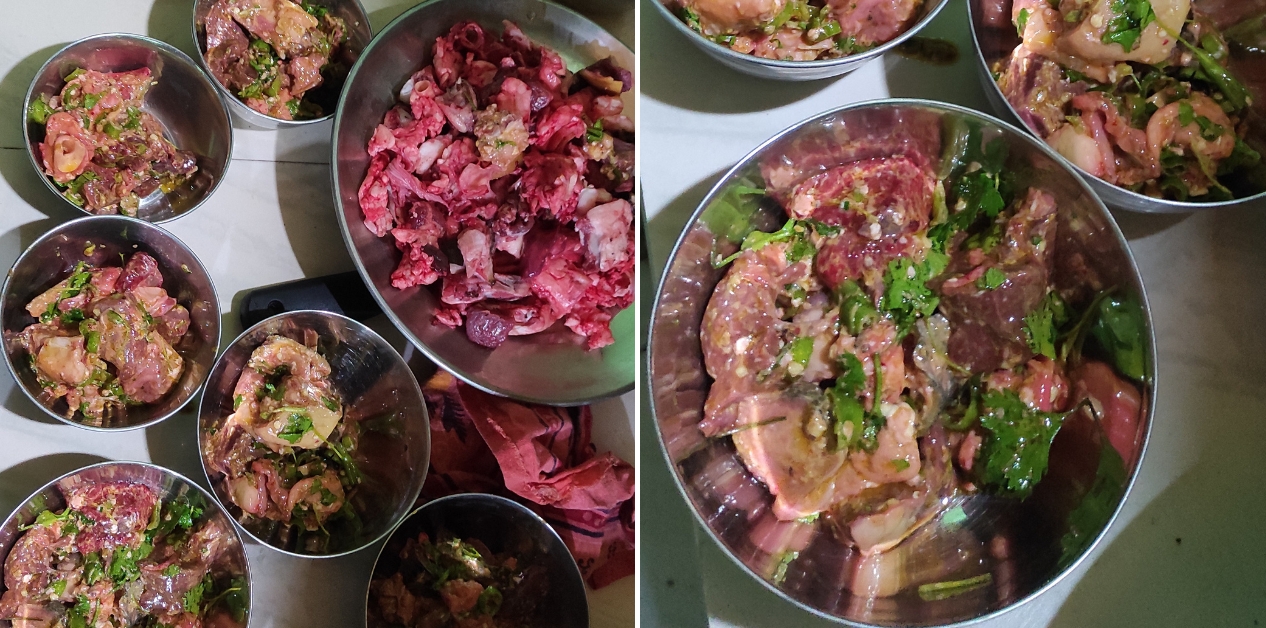

In the alley behind the Kumari House in Basantapur, Kathmandu, there is a small snack house with three tables. The husband was preparing momos in the tiny kitchen behind the counter.
The wife was rolling dough at the table. With her skillful hands, she was mixing minced meat into the dough to make momos. Watching these almost magical actions were two chefs striving to introduce Nepali food to the world: Bikram Baidya, working in the United States, and Binod Baral, working in the United Kingdom. Meanwhile, Bikram Dai said, “The kachila here is very delicious. Try it, brother.”
Washing the mouth that was enjoying chhoyla chiura, a spoonful of kachila was placed inside. It was truly amazing. It melted in the mouth on its own; no chewing was needed. Then, one spoon after another went in. The faces of those placing the kachila in their mouths began to glow with delight.
Even some friends, scared by the health lectures of self-proclaimed social media influencers, could not stop themselves and started tasting the kachila.
In a few moments, the kachila was gone. Then began a discussion about the culture of eating raw meat. Comparisons were made with traditional French tartare, where finely cut raw meat or fish is mixed with small onions, sour capers, parsley, Worcestershire sauce, mustard, and a raw egg yolk.
The South American dish ceviche from Peru was also mentioned. Pieces of raw fish marinated in spicy chili, salt, and sour lime were discussed as suitable for the Nepali palate. Conversations also included Japanese sashimi, consisting of raw fish or other seafood eaten with wasabi and soy sauce.
A few days later, our group of friends was on a work-related trip to Ramaroshan in Achham. While driving on the slippery Karnali highway, the topic of Nepali food came up again. Kachila was mentioned once more. Journalist friend from Doti, Bimal Bisht, said, “We also have a dish like kachila, but not made with goat tripe. We use goat meat.”
Journalist friend from Achham, Dinesh KC, added, “We call it Kachamauli. When a goat is slaughtered, the inner soft part is roasted. These tender parts are cut into small pieces, marinated in spices, and eaten.” Bimal added, “Without mustard oil, there is no Kachamauli. The oil must be freshly pressed from local mustard.”
The discussion about Kachamauli did not end in the vehicle. There was so much talk that it was decided no one would leave Achham without tasting it. But who would make Kachamauli for this group that could not buy it from the market after running around from morning to evening? Bimal contacted sources in Mangalsen.
Early in the morning, he requested them to prepare goat tripe and the kind of tender goat meat needed for five–six people, saying, “Even if it is 10 PM tonight, we will eat Kachamauli.” He told the youngest journalist in the group, KC, “I will prepare the meat; you make the spices.”
By the time we reached the host’s house in Mangalsen, it was already evening. The meat kept in the fridge was roasted over a fire to prevent spoilage. It was then cut into small pieces. Dinesh ground the spices by adding a little cumin, salt, and plenty of green chilies to the mixture in a mortar.
Garlic was sliced thinly. Now it was time to knead. After adding the spices, raw mustard oil was poured in. Half-cooked tripe was also added and mixed thoroughly. After some kneading, Bimal tasted a piece and announced, “It is ready.”
The taste of Kachamauli was truly amazing. When a piece of meat was placed in the mouth, the aroma of raw mustard oil immediately hit the nose. The creamy flavor of the kneaded tripe touched the tongue. The spicy and salty taste provided a delightful sensation.
It was already late at night, so the four pieces were slightly large. They were medium-rare, cooked on the outside but slightly raw inside. The inner part of the meat had reached around 57–58 degrees Celsius, so any bacteria should have been killed.
It was delicious. But there was still concern about digestion. Encouraged by friends saying, “Some people in our area can eat a kilo of Kachamauli in one sitting,” one bowl was consumed, and everyone gave thanks.
Nowadays, Kachamauli is being modernized. Typically, tripe is no longer mixed. The roasted meat is now prepared similarly to a baked dish. Across the Mahakali region, whole goats or sheep are roasted with green chilies over a fire. The meat is removed from the bones and then cooked with turmeric, chili, salt, and a generous amount of mustard oil. It has become a staple during festivals. Some areas now even call roasted fruit or cucumber prepared with green chili, salt, and mustard oil “Kachamauli.”
Even when made from meat stored in the fridge, the taste of far-western Kachamauli lingered on the tongue for a long time. One day, in Bedkot Municipality, Dharampur village of Kanchanpur, I was requesting tea at a shop. Outside on the field, some young men were preparing goat meat. Friends had to wait too.
Suddenly, a young man came forward holding something on a sal tree leaf and said, “Taste this.” It was impossible to refuse such hospitality. I asked, “What is it?” He said, “Kachamauli.” The fine pieces of meat were like those prepared in Mangalsen by Bimal, but the taste was incredible.
And what more was needed? Tea was served, and the taste of Kachamauli accompanied our conversation. This is the authentic local flavor, our own taste, and it is what must be promoted.